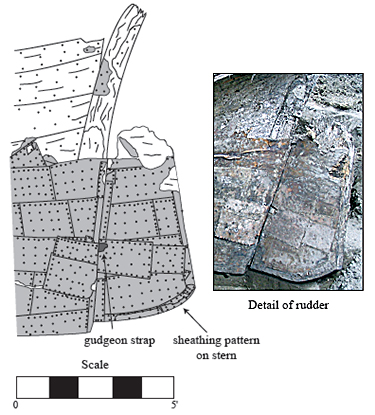
In the Details
Profile view of rudder, along with photographic representation. To see the complete larger version of this image click here.
Every detail, whether it is the size of a fastener hole or the orientation of copper sheathing, holds clues to an artifact's history. It is important that archaeologists, recording in the field or in the lab, capture every discernible feature. Often, details that at first seem mysterious or insignificant reveal themselves as integral to the artifact's story upon further analysis. Methods used by archaeologists to record artifacts range from using pen and paper to advanced digital imaging.
The rudder pictured above was found complete and mounted on the sternpost. Wood sacrificial planking, three quarters of an inch thick, encased the entire rudder. This was covered with copper sheathing. The sacrificial planking and copper sheathing had peeled away from the rear edge of the rudder, revealing a 2-inch diameter bronze bolt head, suggesting that the rudder was constructed of two or more timbers bolted together. There was clear evidence of a major repair to the stern and rudder. The gudgeon and pintle assembly had been strained, apparently from the stern and the rudder striking a large object or the bottom or from some other strain on the rudder that had bodily lifted it. This had strained or loosened the fasteners for the pintle and gudgeon. Rather than remove all the copper and properly repair the damage, only a small amount of copper was pulled free to tighten the fasteners, and copper patches were applied to replace the sheathing removed for the repairs.
Previous
